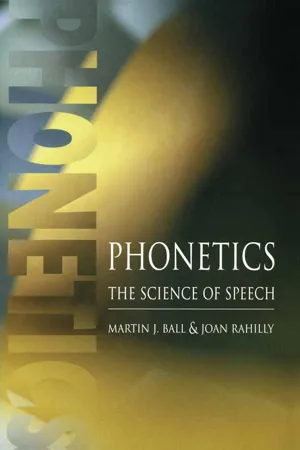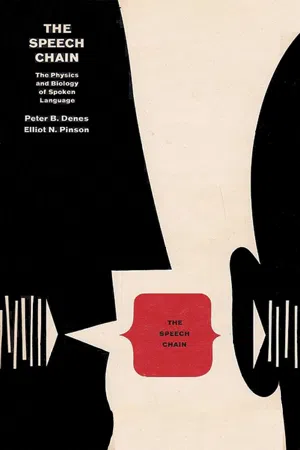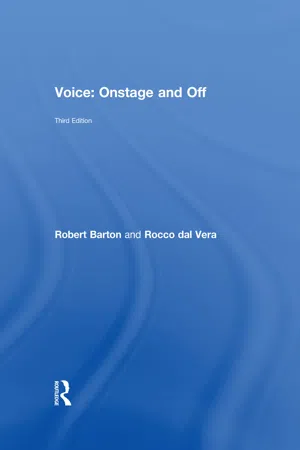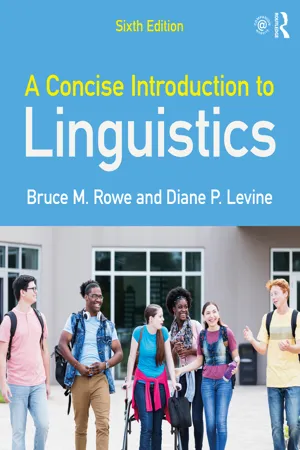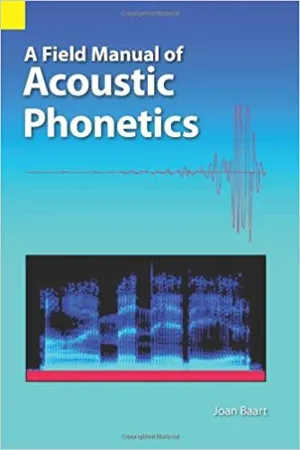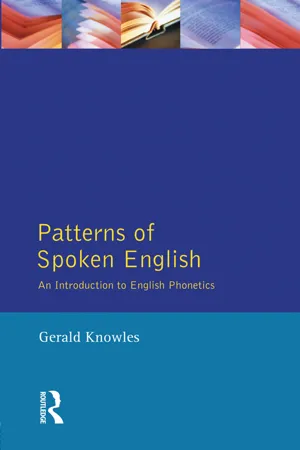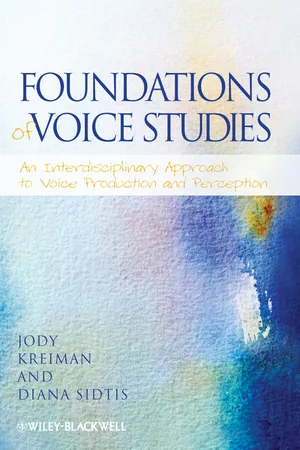Languages & Linguistics
Voiced
"Voiced" refers to sounds produced with the vibration of the vocal cords. In phonetics, voiced sounds are distinguished from voiceless sounds, which are produced without vocal cord vibration. Voiced consonants, such as /b/, /d/, and /g/, are characterized by the presence of vocal cord vibration during their production.
Written by Perlego with AI-assistance
9 Key excerpts on "Voiced"
- eBook - ePub
Phonetics
The Science of Speech
- Martin J Ball, Joan Rahilly(Authors)
- 2014(Publication Date)
- Routledge(Publisher)
utterance usage. It is, however, inaccurate, and so no more helpful than the first usage just described. Although it is true that certain sounds traditionally termed consonants do seem to need a short vowel after them (such as [p], [b], [t], [d], and [k]), many others do not. Tr y, for example to say a long ‘s’ sound without adding a vowel at the end. It should sound a bit like a hissing snake, and is quite easy to produce without a vowel. Similarly, a long ‘m’ sound will be like a humming noise and does not require a vowel. Some languages even have words that consist simply of a consonant sound: the sound [v] in Russian is a preposition meaning ‘in’ (written in the Cyrillic alphabet as ʙ).The utterance usage also will be avoided in this book therefore. However, it is an advance in that it moves us away from writing and towards sound as a definition of these terms. Our next two definitions are often found in the phonetics and phonology literature, and are best considered together. We will terms these the ‘phonetic’ and the ‘phonological usage’, and they derive from attempts by speech scientists to define the terms strictly. One such definition looks at how speech sounds are produced. Some speech sounds are articulated with a relatively free flow of air through the mouth, in that the airflow remains smooth and does not become turbulent. Others are made with a narrowing in the oral cavity (produced by movement of the tongue towards the roof of the mouth, for example). In these cases, airflow is likely to become turbulent, or be blocked altogether for a while. In phonetic usage, the sounds with a free passage of air are termed ‘vowels’ and those with a blocked or turbulent airflow are called ‘consonants’.The phonological definition looks at how sounds work in syllables rather than how they are made. All syllables require a nucleus (or central portion) that is sonorant (referring to the sound’s inherent loudness, and roughly meaning clearly perceptible), and optionally beginning and end portions that are less sonorous. Individual languages have different constraints as to whether these beginning and end portions (‘onset’ and ‘coda’) are optional and what precise sounds can go into these three positions. The nucleus position is occupied by vowels, and the onset and coda by consonants under this usage system.These two approaches to defining consonants and vowels overlap in the majority of cases. However, there some instances where they do not. Sounds like [w] in ‘went’ and [j]1 in ‘yes’ are clearly consonants under the phonological usage (they can be onsets but not nuclei in syllables); however, they are produced with a relatively free passage of air and no turbulence and so would appear to be vowels under the phonetic usage. This is reflected in some of the names these sounds are given in phonetics texts: semi-vowels (older usage, semi-consonants). The same problem is often claimed to occur with sounds like [l] in ‘light’ and ɹ2 - eBook - ePub
The Speech Chain
The Physics And Biology Of Spoken Language
- Dr. Peter B. Denes, Dr. Elliot N. Pinson(Authors)
- 2016(Publication Date)
- Hauraki Publishing(Publisher)
unVoiced .We will describe the articulation of vowels in terms of tongue and lip positions. Some speakers raise their soft palates during vowel production, shutting off the nasal cavities, while others leave it partially lowered. The added nasal quality is not used to distinguish one English vowel from another.It is not so easy to describe the positions of the tongue. The tongue is highly mobile and its tip, edges and main body can move independently. Experience has shown that its configuration can best be described by specifying where the main body of the tongue is. The position of the highest part of the main body is called the position of the tongue.The tongue positions used for making vowels are usually described by comparing them with the positions used for making a number of reference of cardinal vowels . The cardinal vowels are a set of standard reference sounds whose quality is defined independently of any language. They form a yardstick of vowel quality against which the quality of any other vowel can be measured. The cardinal vowel system is basically a system of perceptual qualities, but X-ray experiments show substantial agreement between vowel quality and tongue position. It has become acceptable, therefore, to compare the tongue positions of vowels with those of the cardinal vowels. Strictly speaking, no written definition of cardinal vowel quality is possible because the “definition” of quality is perceived only when listening to a trained phonetician making the sounds. However, we may hazard an approximate definition. When a person moves his tongue as high up and as far forward as he can—without narrowing the width of the air passage to produce a hiss—and spreads his lips at the same time, an “ee” like sound is produced. If he now keeps the tongue high, moves it back as far as he can and rounds his lips, he will make an “oo” sound. If the tongue is moved down as far as possible, still keeping it far back, and the lips are unrounded, he produces a sound very much like the “o” in the word “lo - eBook - ePub
- Robert Barton, Rocco dal Vera(Authors)
- 2017(Publication Date)
- Routledge(Publisher)
hid is more heard than felt. One could say that consonants receive a kinesthetic description, and vowels are described auditorily. Having said that, all sounds are auditory, and all have a feel to them. They are even visual. Notice that audiences will have a much harder time understanding you if they can’t see your lips.UNIT 3.4.1 Voiced and voiceless consonants
Consonants fall into two categories: Voiced and voiceless. On some sounds you use your vocal folds and on others you don’t.EXERCISE 3.4.1.1 SEPARATING Voiced AND VOICELESS CONSONANTS- Place your fingers against your larynx (the front of your throat, or the “Adam’s apple”), and make the vvvv [v] sound again. Feel the vibration under your fingers caused by the vibration of your vocal folds. Now make a ffff [f] sound. The vibration stops. Notice that they are articulated in the exact same way, with your lower lip against your upper teeth. Switch back and forth until you feel and hear the difference between Voiced [v] and voiceless [f].
- Try these contrasting pairs: z/s, b/p, d/t, g/k. The tongue or lip action will be the same for each consonant in the pair, but there are two distinctly different consonants. Since they are articulated in the same way, they are called cognate sounds. The main difference between them is whether or not they are Voiced.
Why is this important? A frequent misarticulation is unvoicing the Voiced word endings.Table 3.2 Comparison of Voiced/voiceless consonant cognatesEXERCISE 3.4.1.2 Voiced ENDINGS- Speak the following pairs of words and listen carefully to the final sounds. The final sounds should be clearly different.
[s]voiceless[z]Voiced
hiss his bus buzz race rays close (adjective) close (verb) dose doze - Repeat the exercise, and make all the endings sound like [s]. How would you describe a person who speaks this way? How does it effect their authority? their intelligibility?
- eBook - ePub
Introducing Language in Use
A Course Book
- Andrew John Merrison, Aileen Bloomer, Patrick Griffiths, Christopher J. Hall(Authors)
- 2013(Publication Date)
- Routledge(Publisher)
Chapter 10Phonetics II: Voiced SoundsKey Ideas in this Chapter- Voiced sounds are produced when air flowing through the glottis causes the vocal folds to vibrate and are the basis for vowels, many consonants, and tone/intonation.
- The distinctive sound of different vowels (vowel quality ) depends on the shape of the oral cavity and the degree of lip rounding.
- vowel quality can be specified with reference to 16 ‘landmark’ vowel sounds, called the cardinal vowels .
- Voiced consonants, like unVoiced consonants, can be characterized in terms of their manner of articulation (e.g. whether there is airflow through the nose) and place of articulation (e.g. whether the lips are closed).
- Approximants are a class of vowel-like speech sounds which are produced when the flow of air through the vocal tract is only partially restricted.
- Assimilation occurs when a speech sound adapts its manner or place of articulation to that of a neighbouring speech sound.
10.1 Introduction
Note: unlike the other chapters in this book (which we believe can be read in any order), this chapter assumes that the reader will already sufficiently understand the material covered in Chapter 9 (Phonetics I).Where Chapter 9 was concerned with voiceless sounds, the current chapter explains voicing and other ways of making sound in the larynx. We start by discussing Voiced consonant sounds. Thereafter, the characteristics of vowel sounds are discussed. Before we reach that discussion, however, it is hoped that you will have developed some acquaintance with the sounds represented by different vowel symbols, from attending to the various examples presented in this as well as the previous chapter. Near the end of the current chapter, there is a section on APPROXIMANTS , a category of vowel-like consonant sounds (such as those at the start of the English words yet, wet and let ).For vowel sounds, air flows freely through the mouth. The sonorous, high energy part of a syllable is usually a vowel. Usually the syllable margins are consonant sounds. APPROXIMANTS - eBook - ePub
- Bruce M. Rowe, Diane P. Levine(Authors)
- 2022(Publication Date)
- Routledge(Publisher)
Table 2.1 lists Voiced and voiceless sounds in English.All sounds can be classified as either Voiced or voiceless. Some sounds differ only in this one characteristic. For instance, [z] and [s] are produced in the same way and at the same location in the mouth, the only difference being that [z] is Voiced and [s] is not.Consonants and vowels
An airstream, usually from the lungs, supplies the energy for speech. The degree of openness of the vocal folds sets up an alternation between oscillating and nonoscillating pulses of air. Yet this is not speech. The airstream must be altered in still other ways before speech will be intelligible. Speech sounds are divided into two major classes, consonants and vowels.Consonants
A consonant is produced when the pulses from the larynx, either Voiced or voiceless, are impeded by a part of the vocal tract. The airstream can be immediately blocked by the momentary closure of the glottis (the gap between the vocal folds) followed by a sudden opening. Such a sound is called a glottal stop, for the location of the interruption of the airstream (the glottis) and the manner in which the stream is interrupted (momentarily stopped). When you cough, even though a cough is not a speech sound, you are creating this type of sound. When you respond with surprise by saying what might be represented in spelling as uh-oh, you are also making this kind of sound. In both cases, you should be able to sense the vocal folds being pressed together.A consonant is a speech sound that is produced when the airstream is constricted or stopped (and then released) at some place along its path before it escapes from the body.The glottis is at one end of the vocal tract above the larynx. The lips are at the other end. In the initial sound of pat, the lips touch each other in a momentary obstruction of the airstream. This type of obstruction is called a bilabial stop - eBook - ePub
- Ali Almanna, Juliane House(Authors)
- 2023(Publication Date)
- Routledge(Publisher)
‘bark’ in a similar way. Which sound is missing in your language?Note that nasals (/m, n, ŋ/), glides (/w, j/), and liquids (/r, l/) are all Voiced. To explain how we can distinguish between Voiced and voiceless sounds, try to place your finger(s) on the voice box (i.e. the location of the Adam’s apple in the upper throat) and say (1) ssssssssssssssss and then (2) zzzzzzzzzzzzzzzz. What do you feel? Is there any vibration? If yes, then the sound is a Voiced sound; otherwise, it is a voiceless sound. To put it differently, at the phonation stage, to produce a Voiced sound such as /z/, the vocal folds are brought together fairly tightly. However, to produce a voiceless sound like /s/, the air passes through the glottis as the vocal folds are set apart.How many vowels are there in your own language?Vowels
Unlike consonants, vowels “are produced in a smaller area of the vocal tract – the palatal and velar regions” (Davenport and Hannahs 2010 : 39). To produce vowels, people use their tongue, lips, and jaw. As such, in describing and classifying the vowels, full consideration is given to these three speech organs. It is worth noting that the most difficult task in describing the vowels is to identify the position of the tongue as it changes its position from one vowel to another without touching any place of articulation (such as teeth, alveolar ridge, palate, velum, or glottis) discussed in the previous section. With this in mind, in producing vowels, there will be no obstruction to the air flow through the mouth. However, the position of the lips and jaw will not cause a big problem as it can be identified by the person without the aid of any instrument.To begin with, let us try to pronounce these two vowels:- /iː/ in ‘see’
- /ɒ/ in ‘watch’
- eBook - ePub
- Joan L. G. Baart(Author)
- 2018(Publication Date)
- SIL International(Publisher)
4 Voice and AspirationIn speech, three mechanisms are used for generating sound: plosion, frication, and voice. In order to produce plosion , an air pressure difference is built up between the two sides of a closure in the vocal tract. The release of this closure causes a sudden stream of air that sets off sound vibrations. In the case of frication, turbulences are generated by forcing air through a narrow constriction somewhere in the vocal tract. (Additional turbulences are generated when an airstream breaks against an obstacle in its way, such as the teeth.) Third, there is Voiced sound , which is produced by a repetitive closing and opening of the vocal folds while air is flowing out from the lungs.The sound signals that are produced at these sources are modified as they travel through a number of resonance cavities in the vocal tract and pass by side chambers. The resonance cavities will strengthen certain frequencies or frequency bands in the sound signal; the side chambers may absorb energy and thereby weaken certain frequencies in the signal. In this way, the resonances and anti-resonances add a specific coloring to the source sound, resulting in audible differences between for instance [e] and [o], or between [s] and [ʃ].All languages have sounds that are Voiced (the sound source is the vibration of the vocal folds; note that this source may be combined with a second source, as in the case of Voiced plosives and Voiced fricatives) and sounds that are voiceless (the sound source is frication or plosion; there is no vocal fold vibration). Many languages use the difference between Voiced and voiceless sounds contrastively, that is: to mark the difference between pairs of phonemes, distinguishing for example [t] from [d] or [s] from [z]. In many languages the difference also plays a role subphonemically, when a certain phoneme has Voiced and voiceless allophones.When there is vocal fold vibration (phonation), it may be of different types. In the phonetic literature a range of modes of phonation is distinguished. There is a continuum of possibilities that is associated with the closeness of the vocal folds: held farther apart or held closer together (Ladefoged and Maddieson 1996:49 ). For the purpose of this chapter we will divide the continuum into three categories only: breathy voice (vocal folds held farther apart; they vibrate, but the closures are not complete; air leaks through the glottis even during the closures; there is a relatively high rate of airflow), modal voice (normal, regular voice; the folds are held close together, allowing for regular vibration with full periodic closures of the glottis), and creaky voice - eBook - ePub
Patterns of Spoken English
An Introduction to English Phonetics
- Gerald Knowles(Author)
- 2014(Publication Date)
- Routledge(Publisher)
CHAPTER 2The Formation of SoundsIn this chapter we shall be describing the formation of speech sounds in some detail. Since everyday language cannot cope with phonetic descriptions, we shall have to introduce a number of technical terms. If you find the vocabulary rather complicated at first, remember that the important things to get to grips with are the fundamental concepts themselves. Phonetic terms are of no value except insofar as they refer to concepts which are properly understood. There is no virtue whatever, for instance, in knowing that /f/ is a voiceless labio-dental fricative, unless you have a clear idea what these terms mean: otherwise you would be much better off simply calling it an /ef/.The basic concepts of phonetics are fortunately very simple, and once you know what to look for, you can make some of the necessary observations directly for yourself. You can usually see something of how a sound is produced by making it in front of a mirror; and for most consonants at least, you can also feel what is going on inside your mouth. It takes a bit of practice to do this precisely and accurately, but many observations require no training at all. Anybody can observe that a /p/ sound is made with the lips, or that the tongue is involved in forming a /s/. If you concentrate on the basic concepts, and on observation, the job of finding the correct technical term quickly becomes a simple matter.2.1 Channels and cavitiesSome speech sounds, including /s, t, ʤ/, appear to be made up of a hissing or rushing noise which may begin or end abruptly. These ‘noisy’ sounds contrast with vowel sounds and a number of consonants, such as /m, n, l, r/, which are rather more musical or ‘resonant’ in nature. This distinction is an important one for the study of sound production, and also of interest for the study of the aesthetic properties of speech sounds.The production of RESONANCE can be illustrated by comparison with a musical instrument such as a Spanish guitar. If you pluck one of the strings of a guitar, it vibrates in a complex way, with a fundamental frequency which you hear as the pitch, and a number of harmonics or ‘overtones’. The vibrations of the string cause the air inside the body of the instrument to vibrate also, and depending on the size and shape of the cavity, some harmonics are strengthened, and others weakened. It is this resonance that gives the characteristic ‘guitar’ quality to the note that you hear. You can play the same note with the same pitch on another instrument, but it will not sound quite identical, as the size and shape of the cavity inside the instrument will be different. - eBook - ePub
Foundations of Voice Studies
An Interdisciplinary Approach to Voice Production and Perception
- Jody Kreiman, Diana Sidtis(Authors)
- 2011(Publication Date)
- Wiley-Blackwell(Publisher)
Phoneticians often conceptualize such patterns as forming a continuum of glottal states from most open (voiceless) to most closed (glottal stop), with intermediate steps in between (for example, Gordon and Ladefoged, 2001). Languages divide this continuum up in different ways, and distinguish different configurations along this continuum. As many as seven modes of vocal fold vibration have been proposed for consonants (Voiced and voiceless, plus breathy voice, slack voice, modal voice, stiff voice, and creaky voice), with a slightly different set (voiceless, breathy, slack, stiff, and creaky) for vowels (Ladefoged and Maddieson, 1996), although authors differ in the number of types distinguished and the terms applied (Gerratt and Kreiman, 2001b). Phonation contrasts on consonants can occur on sonorants like /m/ and /n/, on stops like /p/ and /b/, or on implosive consonants 9 in languages like Hausa (Gordon and Ladefoged, 2001). Most commonly observed is the presence or absence of vocal fold vibration, which in English distinguishes voiceless from Voiced consonants (for example, /s/ from /z/). In other examples, the Burmese word /ma˘/ produced with a Voiced bilabial nasal means “hard,” but when spoken with a voiceless bilabial nasal means “notice” (Gordon and Ladefoged, 2001). Similarly, in Newar (a Tibeto-Burman language) the word /ma:/ spoken with a Voiced /m/ means “garland,” but means “be unwilling” when spoken with a breathy /m/. Creaky phonation contrasts with modal phonation on sonorants in Northwest American Indian languages like Hupa and Montana Salish. (See Ladefoged and Maddieson, 1996, or Gordon and Ladefoged, 2001, for many more examples and details.) Phonation contrasts on vowels also occur commonly in languages. For example, in Gujarati the word /bar/ with a modal /a/ means “twelve,” but means “outside” when pronounced with a breathy /ä/
Index pages curate the most relevant extracts from our library of academic textbooks. They’ve been created using an in-house natural language model (NLM), each adding context and meaning to key research topics.
Explore more topic indexes
Explore more topic indexes
1 of 6
Explore more topic indexes
1 of 4
